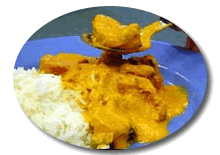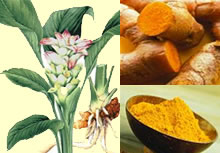Turmeric Food Use : | Turmeric for Food | Composition | Storage | Nutritional Value of Turmeric |
| Cuisine Uses | Cooking Tips |
Turmeric for Food
Turmeric is widely cultivated for its rhizomes which are used as a bright
yellow-orange culinary spice. It has been known as poor man's saffron because it offers a less expensive alternative yellow colouring.
In turmeric, curcumin is the primary pigment and is generally used in various food industries as a food color. It is mainly used in dairy products, beverages, cereal, confectionary, ice cream, bakery, and savory products.
Turmeric is mostly used in flavored milk drinks, cultured milk and desserts to obtain lemon and banana colors in dairy.
Turmeric is added at higher levels to sausages, pickles, relishes, sauces, dry mixes, and fish due to its original usage as a spice.
Composition
- Turmeric contains curcumin and an essential oil
- Dry rhizomes yield 5.8 % essential oil
- Fresh ones yield 0.24 % oil containing zingiberine
- Ketone and alcohol are obtained on volatile distillation
Storage
Turmeric’s color properties is everlasting but flavour and aroma is loss quickly if not store properly. Store it in airtight containers away from sunlight. Store in cool, dark, dry places.
Nutritional Value of Turmeric
Value per 100 grams
- Moisture :13.100 gm
- Protein : 6.300 gm
- Fat : 5.100 gm
- Minerals : 3.500 gm
- Fibre: 2.600 gm
- Carbohydrates: 69.400 gm
- Energy: 349.000 K cal
- Calcium: 150.000 mg
- Phosphorus: 282.000 mg
- Iron: 67.800 mg
In addition, it also contains calcium, phosphorous, iron, carotene, thiamine and niacin.
Two teaspoons of turmeric contains
- Iron: 1.88 milligrams
- Vitamin B: 0.08 milligrams
- Dietary fiber: 0.96 grams
- Potassium: 114.48 milligrams
- Manganese: 0.36 grams
Cuisine Uses
Turmeric is a spice made from grinding the roots of the Curcuma longa plant, also called curcumin. It is a prime ingredient in curry powder and figures heavily in Asian cuisines. Because it imparts a vivid yellow color to the food it is cooked with; it is often used to color as well as flavor condiments, rice dishes and sauces.
prime ingredient in curry powder and figures heavily in Asian cuisines. Because it imparts a vivid yellow color to the food it is cooked with; it is often used to color as well as flavor condiments, rice dishes and sauces.
- It is one of the principle ingredients of curry powder.
- Turmeric can be used as a substitute for saffron.
- It is used to flavour and colour butter, cheese, margarine, pickles, mustard, liquor, fruit drinks, cakes, table jellies, fruit dishes and other foodstuffs.
- Use Turmeric to add Eastern mystery to new favorites as well as in traditional curries, rice and chicken dishes, and condiments.
- Turmeric is a classic addition to chutneys, pickles, and relishes. Add a pinch of Turmeric to fish soups. Blend with melted butter and drizzle over cooked vegetables, pasta, or potatoes.
- In Asiatic countries it is utilized as a food adjunct in many vegetables, meat and fish preparations.
- Turmeric’s small quantity is used in medicine and cosmetics and major quantity of turmeric is utilised as a condiment in India.
- Turmeric oil is also used to impart the flavour in food and perfume industries.
- It adds a warm, mild aroma and distinctive yellow colour to foods.
Cooking Tips
- Turmeric is extremely strong, and actually gets stronger when cooked. A little goes a long way, so use it carefully when experiment it.
- It is a powerful yellow dye; therefore keep away from touching your clothing when working with turmeric.
- Substitute 1 teaspoon dry mustard for 1 teaspoon of turmeric.
- Due to different varieties the color of turmeric can vary from deep yellow-orange to bright yellow.